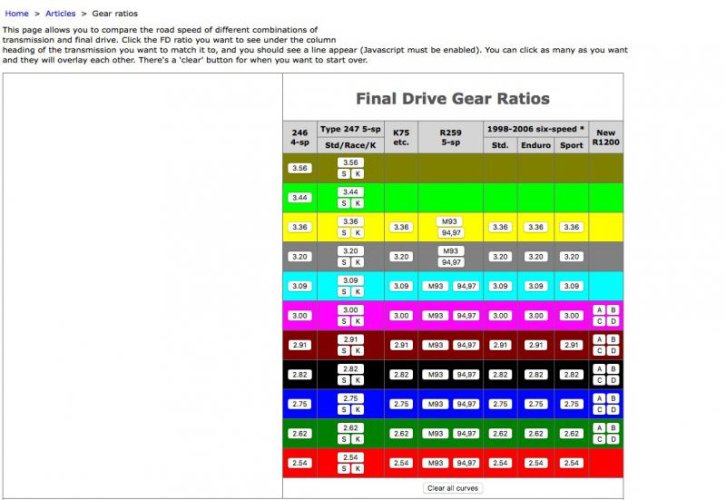davidh21500
New member
Hi -
The previous owner of my '83 R100RS didn't lubricate the rear drive splines. The Good News is, I was able to source a replacement rear end from the same year/model bike with approximately 10K miles on it – the splines are pristine. The Bad News is that it is a 33/11 (3.0) ratio as opposed to the 32/11 (2.91) currently on the bike.
I know I'll need to have the speedo re-calibrated (needs rebuilding anyway), and that I am looking at roughly an additional 500 RPM at 75MPH. An important consideration is that I now live in the great state of Wyoming, where we have open roads and 80 MPH posted speed limits. That would seem to indicate the original 32/11 (2.91) is preferable.
I'd like to hear real-world experiences from riders who have ridden with both ratios on the same/similar bike. I'm looking for both empirical (measured observations) and subjective ('seat of the pants') experiences. I'm especially interested in the effect on high-speed (75+ MPH) cruising, as that will comprise the majority of my riding. Long-distance is implied; after all it is a BMW …
Bottom Line, I need to decide to go with the 33/11, or sell/trade the 33/11 for another 32/11. I'm leaning slightly towards having another 32/11; however, I'd like to better understand the real differences so I can make a more informed decision.
Thanks in advance for any comments, recommendations, opinions, etc.
David
The previous owner of my '83 R100RS didn't lubricate the rear drive splines. The Good News is, I was able to source a replacement rear end from the same year/model bike with approximately 10K miles on it – the splines are pristine. The Bad News is that it is a 33/11 (3.0) ratio as opposed to the 32/11 (2.91) currently on the bike.
I know I'll need to have the speedo re-calibrated (needs rebuilding anyway), and that I am looking at roughly an additional 500 RPM at 75MPH. An important consideration is that I now live in the great state of Wyoming, where we have open roads and 80 MPH posted speed limits. That would seem to indicate the original 32/11 (2.91) is preferable.
I'd like to hear real-world experiences from riders who have ridden with both ratios on the same/similar bike. I'm looking for both empirical (measured observations) and subjective ('seat of the pants') experiences. I'm especially interested in the effect on high-speed (75+ MPH) cruising, as that will comprise the majority of my riding. Long-distance is implied; after all it is a BMW …
Bottom Line, I need to decide to go with the 33/11, or sell/trade the 33/11 for another 32/11. I'm leaning slightly towards having another 32/11; however, I'd like to better understand the real differences so I can make a more informed decision.
Thanks in advance for any comments, recommendations, opinions, etc.
David



